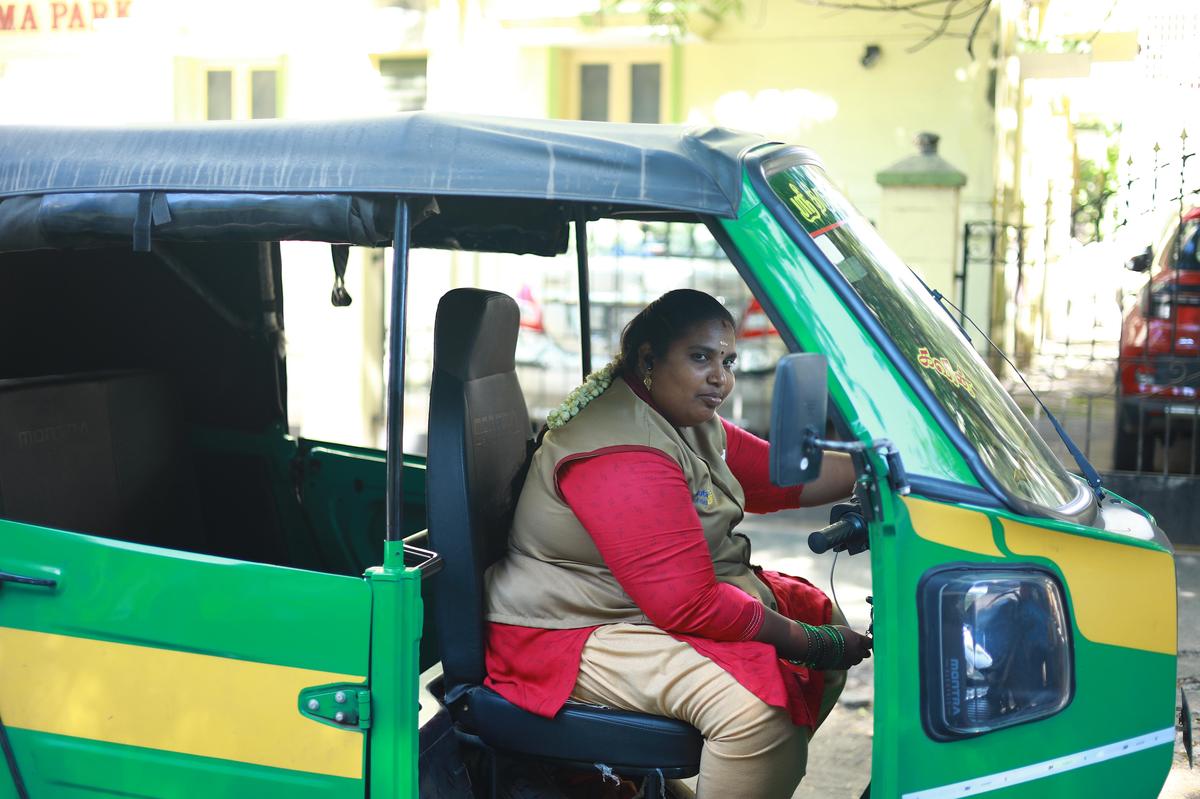
R. Santhalakshmi, a resident of Palavakkam, steers the wheel of an autorickshaw that treads softly on the planet. It is an e auto. She has been an autorickshaw driver for five years — out of which four and a half years had been spent driving a conventional auto, one fitted out with an internal combustion engine and running on fossil fuel. Though only five months into driving an e auto, Santhalakshmi seems to be navigating the challenges that go with driving one, reasonably well.
| Photo Credit: PRINCE FREDERICK
In the last seven months as an autorickshaw driver, Pavithra Prakash has learnt some hard lessons about driving an electric vehicle. “Once charged, my auto can run for 160 km and I make it a point not to cross 110 km,” says the 29-year-old mother, happy about the financial independence ushered in by her new job. She has “range anxiety” whenever the three-wheeler crosses that mark as it is usually difficult to find an EV charging station nearby. Even if she were to charge at a public charging point, it would require her to wait for a few hours.
“Once I was left with charge for just 30 km and the vehicle started making alarming sounds, I panicked as my house is located near Red Hills and I just wanted the charge to be sufficient for me to reach home,” says the autorickshaw driver who charges the vehicle at her home.

Pavithra’s husband, who has an auto running on compressed natural gas, encouraged her to opt for an electric vehicle for the ease it would offer the young driver who learnt driving skills from Association of Non-Traditional Employment for Women (ANEW) in Anna Nagar.
“On days when I get many rides I am forced to wind up by 2 p.m. as the vehicle does not have charge. I sometimes refuse long-distance trips fearing the situation that would manifest if I run out of charge,” says Pavithra.

Pavithra Prakash has “range anxiety” whenever her three-wheeler crosses the 110 km mark
Anxious if the battery will drain out, autorickshaw driver R. Shanthalakshmi only takes shorts trips in and around Palavakkam where she resides. “When I purchased the vehicle from a showroom in Tambaram, they told me there are public charging stations I could use, but in the five months since I have been driving this vehicle I have not discovered even one, so I charge the vehicle every night at home,” says Shanthalakshmi, who is content earning ₹1000 to ₹1500 a day ferrying people. Her income as an autodriver is supplemented by earnings from petty shops she runs near her home.
Showrooms retailing three-wheelers say the demand for electric vehicles is noticeably greater than what it was last year. In March this year, Chief Minister M.K. Stalin handed over 50 electric autos to women members of urban self-help groups under the Environment and Climate Change Department to empower them to be financially independent while promoting sustainable mobility.
“Unlike public charging stations for two-and-four-wheelers, there is no such facility for autorickshaws. Some showrooms selling the vehicles make provision for charging outside their store,” says R. Ashwanth, manager, Rag Motors. He says there are two variants in three-wheelers: one has 125 – 150 km range and the other 200-250 km, a majority go in for the latter and are happy as their everyday travel is usually covered by that range.
Those in the industry say public charging infrastructure should keep pace with electric vehicle sales. Giving subsidy to vendors will also encourage establishment of more facilities.
No standardisation
Ragavendra Ravichandran, co-founder and chief operating officer, Plugzmart, agrees the charging infrastructure for three-wheelers is yet to pick up. The chargers currently used by electric autos have not been standardised.
“For electric four-wheelers, there is broad standardisation among major brands when it comes to charging interfaces. AC chargers typically use the Type 2 connector, and DC fast chargers commonly use the CCS2 (Combined Charging System) connector. This allows vehicle owners to access public charging infrastructure with a standardised plug wherever they go. However, this level of standardization does not yet exist for electric three-wheelers Many manufacturers use proprietary connectors leading to compatibility issues and a lack of universal public charging access,” says Ragavendra.
Electric autos used for transporting goods go to warehouses for charging; and those used for ferrying people are dependent on public charging stations or homes, he says.
Is it okay to charge an electric vehicle at home? Yes, but it may not be as fast as a public infrastructure point. Many prefer to charge vehicles at home for the convenience it brings. A Tangedo official says so far there is no restriction on charging electric vehicles at home for domestic use, but if a petty shop is offering it at a fee to users then they must have a separate meter with commercial tariff.
Published – June 15, 2025 11:06 am IST